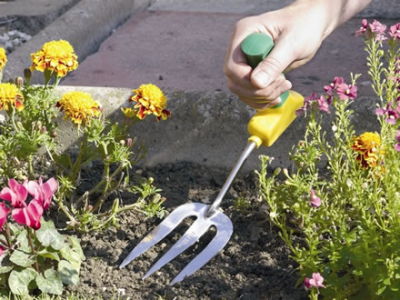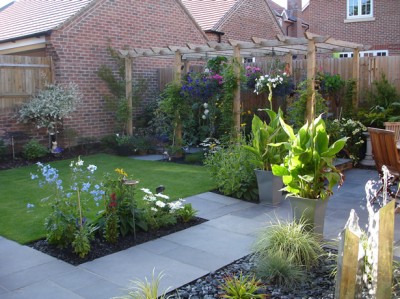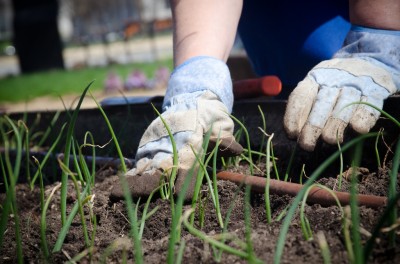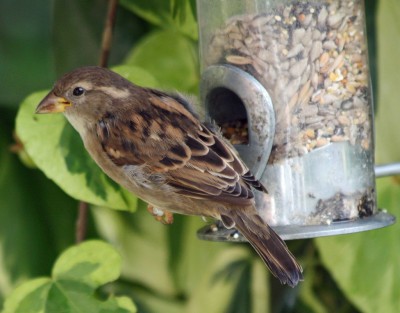Easier Maintenance Gardens
First off, let me say what this blog post is not. It’s not about low maintenance gardens, although many of the tips below are indeed applicable to those looking for a low maintenance garden.
Rather, it’s intended for those who love gardening and its therapeutic benefits, but either have a disability, are physically less able or just short of time.
And because, let’s face it, some gardening jobs are tough on the joints of even the fittest of individuals, this is also for anyone who simply wants to make gardening that little bit easier! If you have any tips based on your own experience, please do add them as a comment at the bottom.
1: Tools | 2: Planning | 3: Easier Access | 4: Effort Saving
1: Tools

There are many devices on the market that can help to make gardening easier. Have a look at:
- Thrive: http://www.carryongardening.org.uk/shop/. Thrive is a national charity that helps people with a disability to start or continue gardening, with lots of advice & a large products section. Have a look for example at the secateurs – ratchet, power lever, battery powered, cut and hold secateurs – you name it, they have it!: http://www.carryongardening.org.uk/shop/secateurs-c9cb3a11/default.aspx.
- Peta (UK) Ltd: http://www.peta-uk.com/acatalog/Assistive_Garden_Tools.html – Easi-Grip® range of tools (see photo), with a specially angled handle making them comfortable to use. The range includes long-reach tools, an arm support cuff and also a device which you can use with existing tools for an ergonomic grip.
- Arthritis Research UK: http://www.arthritisresearchuk.org/arthritis-information/arthritis-and-daily-life/gardening-and-arthritis.aspx – features a useful PDF information booklet (see right hand side of page) to download.
- Fredshed: http://www.fredshed.co.uk. Garden tools and equipment tested by Fred Walden, garden writer and equipment consultant to the NHS. Tools for people of any ability, but many are useful to those with limited mobility or strength.
2: Planning
-

An obvious one, but often missed… choose the right plants!
- Grow the plants you really like / want
- Think about slower growing shrubs, or those needing less pruning, or spraying, or staking, or tying in, or……
- Fill your garden with lots of low / easy maintenance plants, so that you have time to spend maintaining the few prized prima donnas who gobble lots of your time – these might, of course, include a few veggies
Creating a cohesive planting plan for an easy maintenance garden can be quite a task. Contact us if you’re feeling swamped & would like some professional advice.
- Consider having fewer beds and borders, and more lawn. Or having less lawn (= less mowing) and more hard surfaces (such as gravel and/or paving). Think about your priorities. Are there plants you specifically want to grow? Could you have a few beds and borders devoted just to these, with perhaps the rest of the garden being laid to lawn, gravel and paving?
- This doesn’t mean that the garden has to be boring! The lawn and borders can be attractively shaped and interlinked. But try to avoid little fiddly bits of lawn which are tricky to mow, and make sure any curves are big wide sweeps. Avoid cluttering the lawn with lots of little bits of border – as these too can make lawn mowing awkward. Another one to consider – is it worth opting for artificial turf rather than lawn? You can read about some of the pros and cons of artificial lawn here.
- Choose path and patio surfaces carefully. Some materials take more looking after than others. For example, dark paving such as slate and granite can look dusty all the time and need sweeping frequently if a pristine look is required. Consider sealing your paving – see our blogs posts on choosing a new patio and patio maintenance.
3: Easier Access
-

Think about installing some raised beds or big timber planters so that you don’t have to bend as far – just be careful not to make them too wide. Taking this one step further, Instaplanta’s concept of planters with inner containers that can be removed and planted up inside/elsewhere is an interesting one.
- Install paths within borders for easier access when weeding and pruning. Even just a few stepping stones can help.
- Is part of your garden lawn only accessible via steps? Consider replacing these with a ramp to make lawn mower and wheelbarrow access much simpler.
- If your garden slopes down into the boundary fence / wall, think about installing a retainer inside the boundary fence and then levelling the ground. This can be as straightforward as a simple piece of timber. Weeding is hard enough on level ground… if the ground slopes away from you, it can be back breaking!
4: Effort Saving
 Think about mulching borders to reduce weeding time – the mulch will help stop the weeds growing; worms will help work the mulch into the soil.
Think about mulching borders to reduce weeding time – the mulch will help stop the weeds growing; worms will help work the mulch into the soil.
- Many of us (me included!) love feeding the birds, but the ground beneath bird feeders can get very messy, and also very weedy – birds don’t always eat all the seed they are given (mine don’t like the carrot seed in some mixes, and I end up with carrots growing all over the garden!). Think about placing some low cost paving or cobbles below your bird feeders.
- If your garden is on the large side, consider dotting items such as water butts and compost bays in various locations around the garden so that you don’t have to travel great distances when weeding, mowing and watering.
- Similarly, think about locating structures such as sheds, greenhouses and cold frames close together.
- Having an irrigation system installed will save watering time – and prevent you having to lug heavy watering cans/pull cumbersome hoses about. Ask us for more details.
Photo credits: http://www.peta-uk.com (Easi-Grip® Fork), usdagov (hands on gardening), gareth1953 (sparrow on feeder)